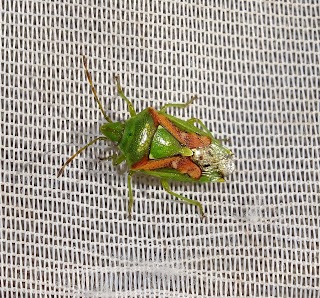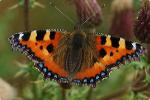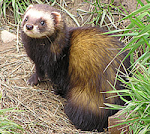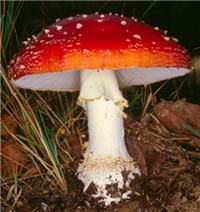Thursday, 24 September 2020
So now we know.
It is not really a surprise that we are facing stricter regulation to our lives. It has however, wiped out any prospect of restarting the Joy of Wildlife group in its usual form until next Spring at the earliest.
Anyway, on more joyous subjects, I continue to be sent lots of wonderful photographs which I would like to share with you, as well as providing a bit of information on outings that have been managed during this prolonged period of reduced activity.
If anyone has anything they would like me to include please feel free to contact me.
Which is what Neil did with some photographs of rarer beetles that he has managed to root out over the past few months, although the first appears to have rooted him out!
 |
| Photograph: Neil Nash |
A longhorn beetle Molorchus minor which has been given the common name Spruce shortwing beetle. How it can confuse this bit of exposed body for a spruce is beyond me. A delightful find. This is an insect that has not been seen very often in Shropshire. Neil's knee (I assume it was his) and the beetle were in the right place at the right time. The right place was Lee Brockhurst.
Neil's next excellent beetle find is a first for the county. This was Silpha tristis, a carrion beetle, at Whixall Moss.
 |
| Photograph: Neil Nash |
And finally, at the Millenium Village in Telford Neil came across Leptura quadrifasciata.
 |
| Photograph: Neil Nash |
This beetle has been given the common name Four-banded longhorn beetle, which looking at the pattern on its elytra is understandable. But the markings are not really bands. Perhaps it should be called the Eight-splash longhorn - sorry, I cannot think of a better description of the yellow markings.
The Millenium Village is one of the many sites the Joy of Wildlife group planned to visit this year. All being well we will try again next year.
News from Madeley.
Someone is turning their lawn into a meadow.
 |
| Photograph: Nigel Cane-Honeysett |
The plan was to spread this area with green hay collected from a churchyard in Hopesay. Permissions were granted and arrangements made. BUT....
Someone got in first, cut the churchyard and removed all the hay!!
Plan B - the area in the photograph has now been seeded instead. I look forward to seeing the results.
Finally before moving on to happenings in September. If you are a regular reader you will remember this photograph of Palloptera muliebris:
 |
| Photograph: Jim Shaw |
It seems that I am the gullible victim of a spoof!
On reading the blog that contained this photograph and the my reference to its common name - the Dame Edna fly - I was contacted by C Midwinter, the author of the article in the Shropshire Entomology Newsletter that introduced me to the name. This is what he had to say:
"Just to clarify the Dame Edna fly name. I and a friend had been joking about this when I worked at FSC after I produced a photo of them together. Having previously put a spoof article in an early Shropshire Entomology newsletter I decided to insert one into newsletter 6 (Oct 2012) under a pseudonym on the Dame Edna fly and the name seems to have stuck, to my delight!"
I will let you guess whose pseudonym is C Midwinter.
You can see the original article by following this link Shropshire Entomology Newsletter Issue No 6.
The article starts on page 15.
On the first day of September I journeyed on a glorious summer's day to the Earl of Bathurst's Estate at Cirencester Park to meet with our orthopterist to look for Woodland grasshoppers.
Cirencester Park contains a huge area of woodland punctuated by wide rides. And, surprisingly, you look for the Woodland grasshopper in the grassland of the rides rather than the woods.
Careful searching plus the aid of a bat detector, which is used to bring the male grasshopper's call into the human audible range soon revealed the target species Omocestus rufipes.
 |
| Photograph: David Williams |
Interested as I was in this insect I was also on the look out for hemiptera. Whilst observation and patient searching are not some of my better attributes, I do wield a mighty sweep net. And the sweep net yielded a Crucifer (or Brassica if you prefer) shieldbug, Eurydema oleracea.
 |
| Photograph: David Williams |
To be fair, although I swept it up, I did not notice it in the net. Fortunately my more observant colleague came to the rescue.
He followed this up by spotting a Tortoise shieldbug, Eurygaster testudinaria, in the grass.
Fungi were a feature of the site with many fruiting bodies visible. Some of the ones we managed to identify were:
Amanita excelsa var, spissa;
 |
| Photograph: David Williams |
Finally, I did manage to find and photograph something all on my own - the rather bizarre looking weevil, Apoderus coryli, otherwise known as the Hazel leaf-roller.
From Cirencester Park we made the short trip to Rodborough Common to look for Great green bush crickets, Tettigonia viridissima.
Despite my difficulty in locating the correct car park we eventually got onto the common to search for our quarry. The bush crickets are usually found in scrub within grasslands. We searched lots of bramble and other scrub patches until, eventually, one was heard (not by me) and was tracked down to a bramble patch.
 |
| Photograph: David Williams |
It seemed reasonably unconcerned by out presence and interest but disappeared as soon as I got my camera out.
Still I did have some bush cricket success when my more heavy handed approach to finding them beat a Speckled bush cricket, Leptophyes punctatissima, out of a small Scot's pine.
The following day a few of us met up at Prees Heath for some socially distanced entomology. It was not a nice day and persistent drizzle curtailed our activities at lunchtime. When he got home, our arachnologist found that a spider so wanted to be identified by him that it had hitched a lift on his rucksack - Aranaeus quadratus.
 |
| Photograph: Nigel Cane-Honeysett |
A couple of days later I was sent a couple of photographs of bugs that had been spotted during a visit to a graveyard in Wordsley.
The first is a Birch catkin bug, Kleidocerys resedae. This bug is very common on birch trees but crops up almost anywhere (including heather where it is easy to confuse with the similar heather-based bug Kleidocerys ericae).
 |
| Photograph: Bob Kemp |
The second bug, actually two bugs, that preferred gravestones to their usual habitat, are Forest bugs, Pentatoma rufipes, that are too busy creating the next generation to worry about their surroundings.
 |
| Photograph: Bob Kemp |
In the second week of September following agreement from Caring for God's Acre and permission from Bridgnorth Council a small group visited Bridgnorth Cemetery.
The September weather was wonderful. Too good really as it encouraged a lot of sitting around enjoying the sun and socially distanced company. Rest assured we also did plenty of searching.
Fungi were a feature of the site with many fruiting bodies visible. Some of the ones we managed to identify were:
A mushroom that lives up to its name - Death cap, Amanita phalloides;
 |
| Photograph: Bob Kemp |
Amanita excelsa var, spissa;
 |
| Photograph: Bob Kemp |
Finally, what turned out to be only the third county record of Limacella guttata.
 |
| Photograph: Bob Kemp |
Despite all the fungi, for me the star of the day was a Box bug, Gonocerus acuteangulatus.
 |
| Photograph: David Williams |
Remarkably the Box bug was beaten out of a small section of box hedging. For once an insect that lives up to its name.
This bug is a very recent arrival in the county. It was first recorded last year and this latest find represents its third recorded sighting.
A bush covered in ivy attracted the attention of one of the group. He spent ages looking at and taking photographs of the ivy. What was the great interest?
Ivy bees, Colletes hederae.
 |
| Photograph: David Williams |
The Ivy bee is another recent colonist within the county but it has spread rapidly and if you have flowering ivy you stand a reasonable chance of seeing it feeding on the plant. Unfortunately whenever I see a bee feeding at ivy it turns out to be a honey bee - but I will keep looking.
Another hymenopteran that was quite common in the cemetery was the field digger wasp Mellinus arvensis.
 |
| Photograph: David Williams |
And, to round off this visit to the cemetery, we found a Juniper shieldbug, Cyphostethus tristriatus.
On the following Friday, 11 September, I visited Port Sunlight River Park on the banks of the River Mersey for a Tanyptera Trust Recording Day.
The River Park is the result of the "restoration" of a landfill site. The site has been capped and "returned to nature". Part of that return is to syphon off the gas produced by the site and use it to supply energy to nearby housing. The landfill site is also unusual in that it is a dome and stands a good height above the surrounding countryside and the river, affording good views from the top. The site is mainly grassland with some woodland and scrub as well as a large pool.
The visit started with an inspection of a wild patch by the visitor centre. This provided an immediate surprise when several distinctive nymphs of the Southern green shieldbug, Nezara viridula, were found.
As suggested by its common name this insect is found mainly in the south of England, especially around the Greater London area, but there are a scattering of records heading north and west. You never know it may turn up in Shropshire.
One insect that I did not have to look for was an Angle shades moth, Phlogophora meticulosa, which took a fancy to the tube of my vacuum sampler.
And as I was returning to the car to wrap up for the day I passed a Rosemary bush, gave it a tap, and out fell a Rosemary beetle, Chrysolina americana.
Whilst I was on the banks of the Mersey our Lichenologist was in Sutton Park where he found this parasitic fungus on a Lepraria lichen.
 |
| Photograph: Bob Kemp |
I finish with another example of what earwigs get up to when you are not looking. This one had decided to take up residence in a photo frame, being exposed when the frame was opened.
 |
| Photograph: Nigel Cane-Honeysett |
Just in case you cannot see it in the above photograph, here is a close up.



































No comments:
Post a Comment
Please feel free to comment on this post...